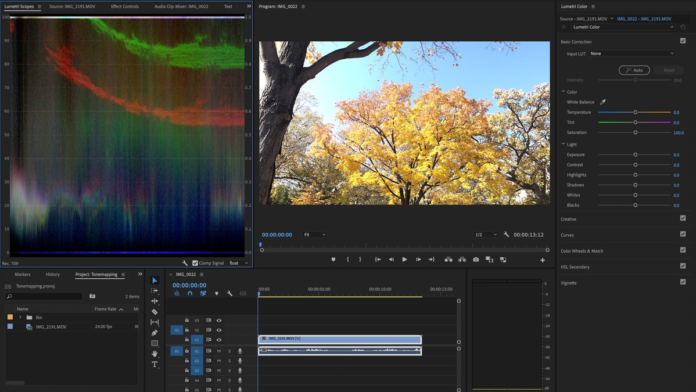Among the most intriguing updates coming to Adobe’s video editing and motion graphics software are text-based editing and enhanced transcription in Premiere Pro.
Ahead of NAB 2023, the video industry’s major conference in Las Vegas, Adobe also detailed upgrades coming to After Effects and Frame.io. And no tech software announcement can avoid mentioning generative AI these days. Adobe talked up its text-prompt-based image generator, Firefly, and posited some use cases that could someday come to Premiere Pro and After Effects.
“We’re exploring the potential of natural language content creation with Firefly so you can describe what look you want and instantly change the colors and settings to match,” Adobe says.
Text-Based Editing
(Credit: Adobe)
Adobe previously added automatic transcription to Premiere Pro, but with this update, you can edit video based on that text. You can search for words or phrases and add the clip section to the timeline with a click. This also enables you to quickly remove sections where the speaker pauses with ripple deletes based on the transcript. Once you’ve cut and moved the bits around based on the transcript, you can instantly create captions in the project.
These editing features are currently in public beta and are expected to ship in May.
Premiere Pro’s new Automatic Tone Mapping and log video detection automatically manages color in a project. It lets editors mix and match video from SDR and HDR sources, and automatically applys the correct LookUp Tables (LUT), which saves editors from having to search for the right LUT for each source camera and apply it separately.
It’s a simple matter of making sure you check the new Auto Tone Map box in the Sequence Settings panel and the Auto Detect Log Video Color Space box in the Preferences panel. The feature supports smartphone content as well as pro video cameras from DGI, Panasonic, Sony, and Canon. Adobe reps didn’t mention pro cameras from RED and Arri, but it’s a good bet that support for those is coming, since the company announced improved format support for the RED V-Raptor X and the ARRI Alexa 35 at the press briefing.
Better Performance
Adobe also announced that this is the fastest version of Premiere Pro the company has ever released, and it will take advantage of GPU acceleration for more functions, including transitions, effects, title templates, and color scopes.
Small But Noteworthy User Requests
Adobe likes to address user requests, and this version update is no exception. None of these will make headlines, but they could certainly make editors’ lives easier. Here’s a snapshot from Adobe’s presentation of these less-earth-shattering helps:
(Credit: Adobe)
Collaboration Improvements
Collaboration tools in Premiere Pro also see improvements, like progressive project loading, which saves editors from having to wait for a whole large project to load before they can start working. Another new feature that editors will love (trust me, as one who’s lost work by forgetting to save) is background auto-save. And the new Sequence Locking feature means that collisions between editors can be avoided, with one editor able to lock a sequence, which becomes temporarily read-only to other collaborators.
Recommended by Our Editors
After Effects Updates
After Effects, now in its 30th year, sees updates in this announcement, too. Its new Properties panel saves motion graphics editors from having to dig down into timeline layers and choices to change the object they’re looking at and working on. New integrations for OpenColorIO (OCIO) and its Academy Color Encoding System (ACES) will be important for motion picture editors, allowing them to achieve consistent colors while working in various other applications. After Effects also gets community-requested capabilities, such as multi-frame shape rendering and keyboard shortcuts for Selectable Track Mattes.
Frame.io Now Works With Photos
(Credit: Adobe)
Frame.io, the standard cloud collaboration service for pro video editors, having come into the Adobe fold, gets a few notable new capabilities at this year’s NAB.
Interestingly, it will now support camera raw files, courtesy of Photoshop’s Camera Raw module. Still photo cameras will be able to take advantage of the platform’s Camera to Cloud feature, which is similar to tethering, except instead of photos appearing on a connected PC, they appear in the cloud, ready for collaborators.
The company announced Camera-to-Cloud support for Fujifilm X-H2 and X-H2S cameras. And an open API will let third-party applications like Capture One integrate with the cloud sharing service. Frame.io’s security is being beefed up, meanwhile, with “forensic watermarking” that follows content no matter how it’s copied, edited, or transferred.
Get Our Best Stories!
Sign up for What’s New Now to get our top stories delivered to your inbox every morning.
This newsletter may contain advertising, deals, or affiliate links. Subscribing to a newsletter indicates your consent to our Terms of Use and Privacy Policy. You may unsubscribe from the newsletters at any time.
Hits: 0
















